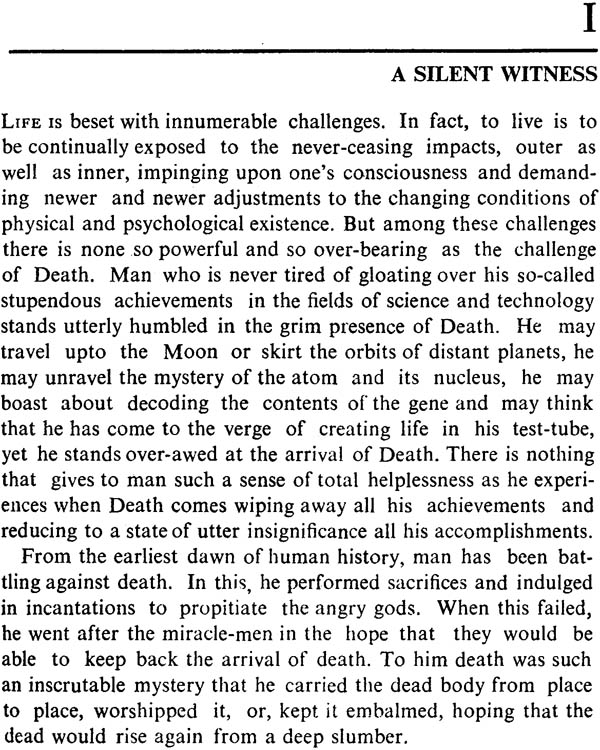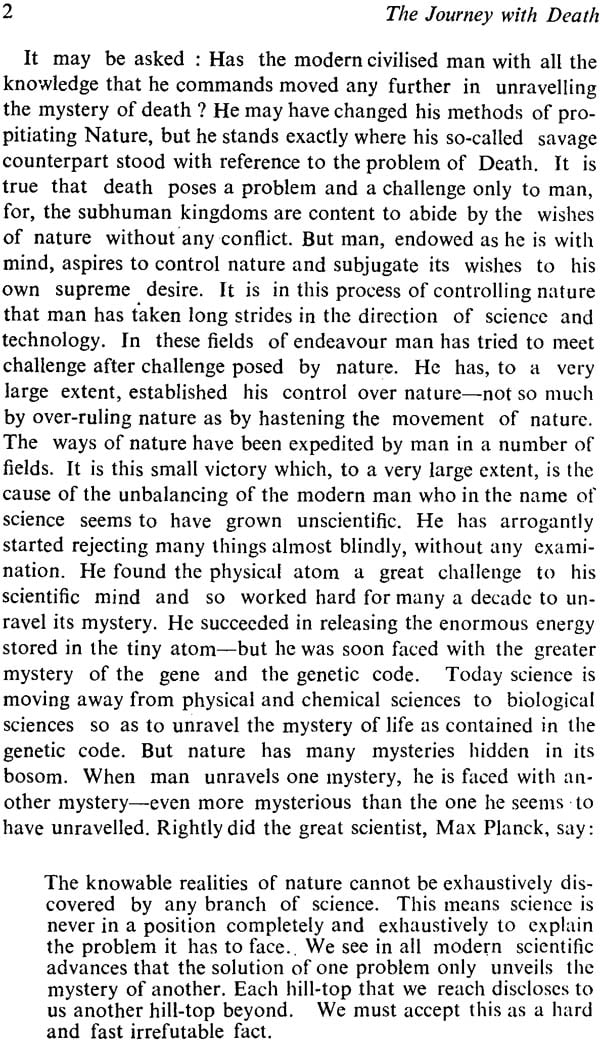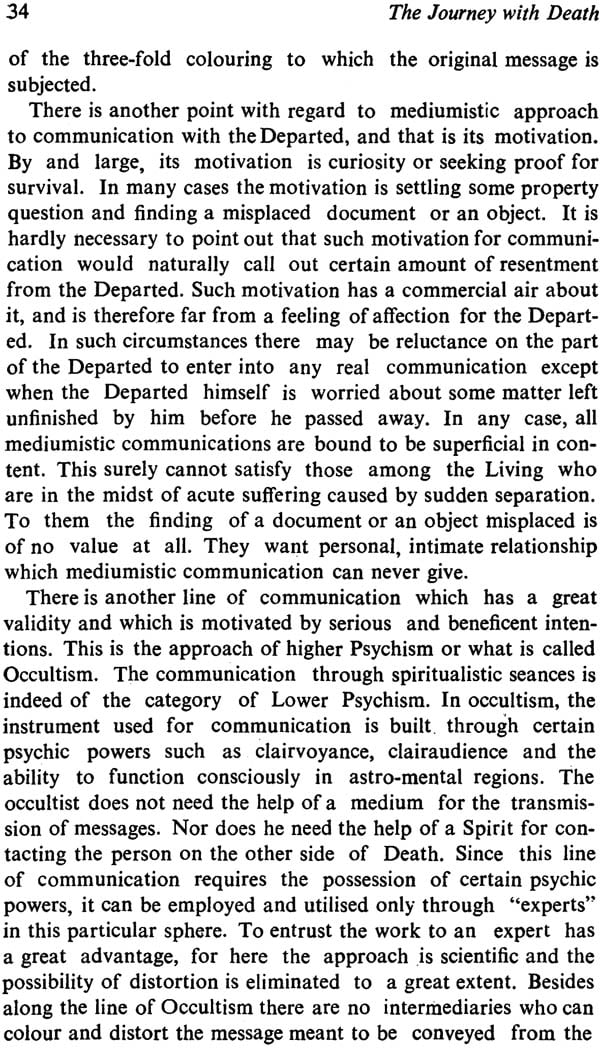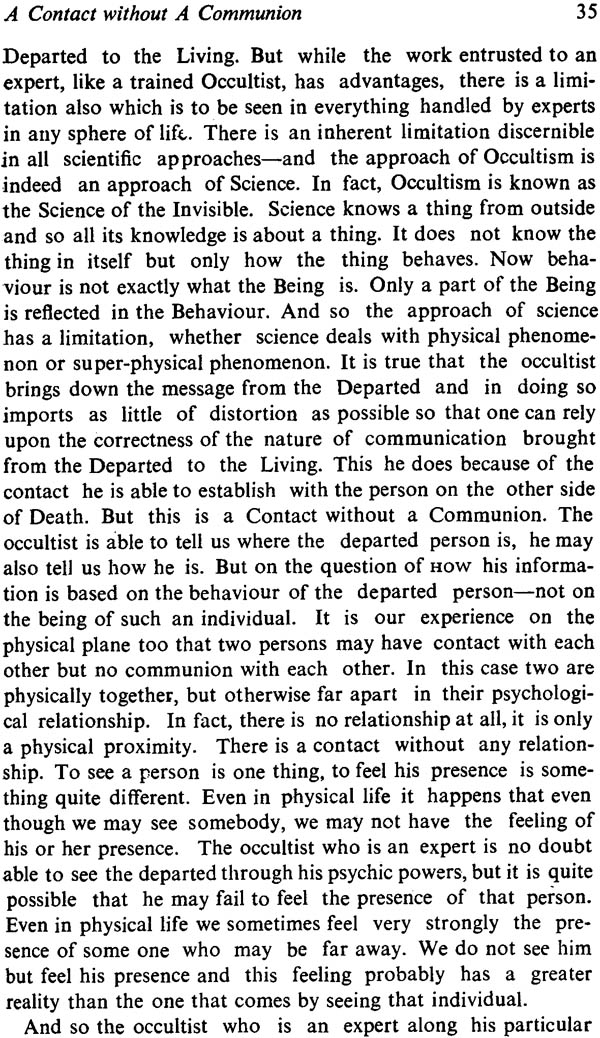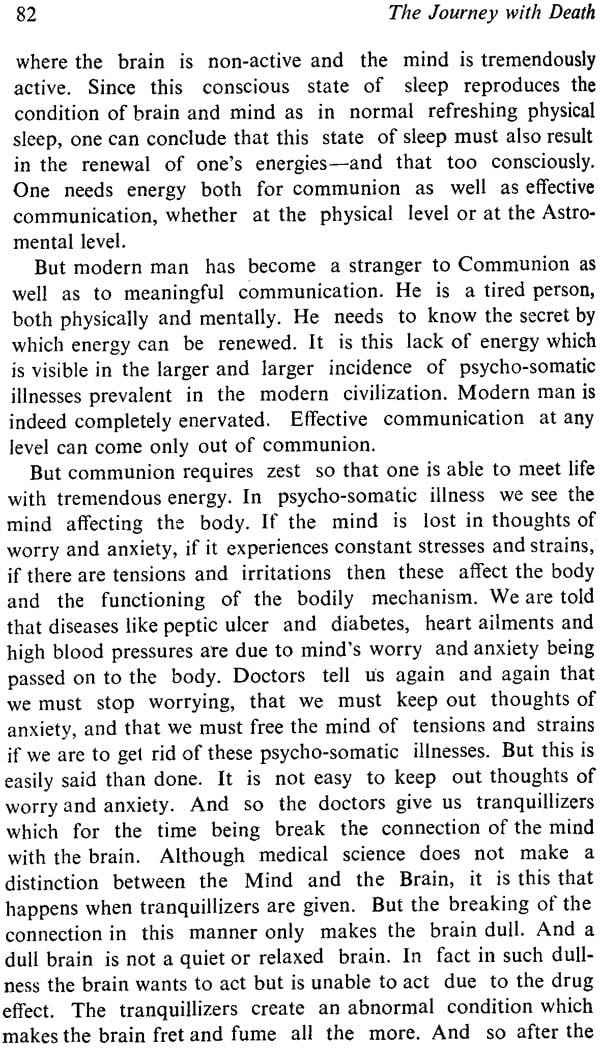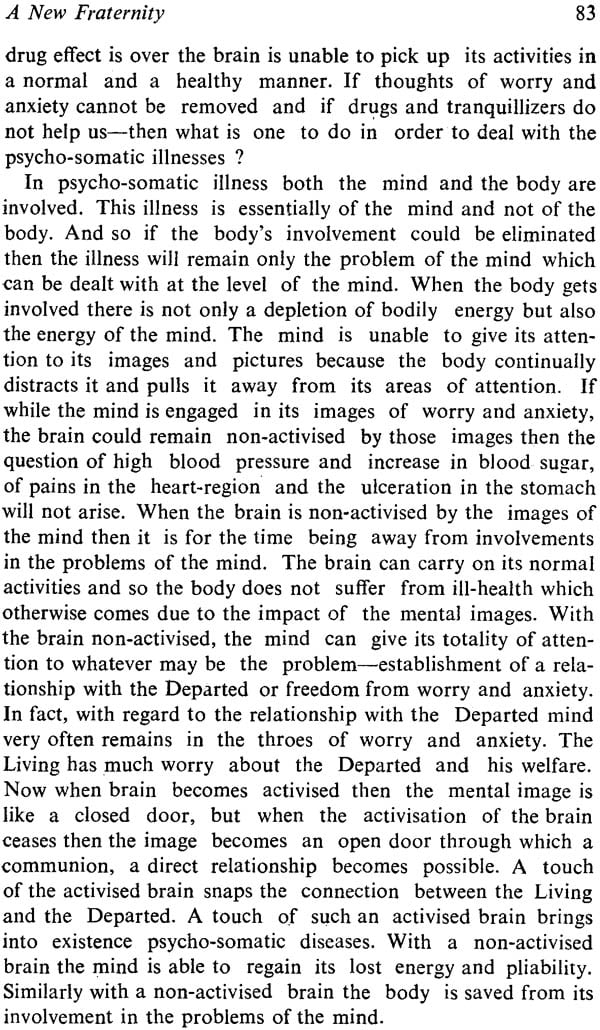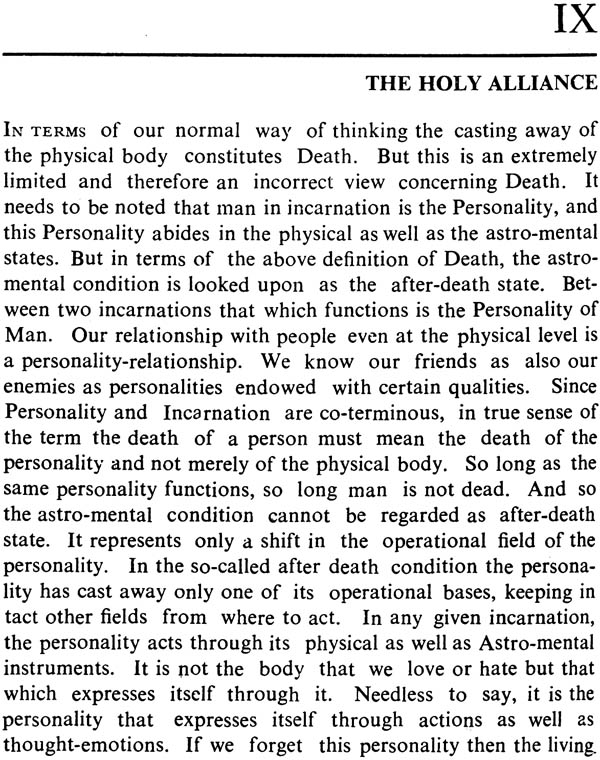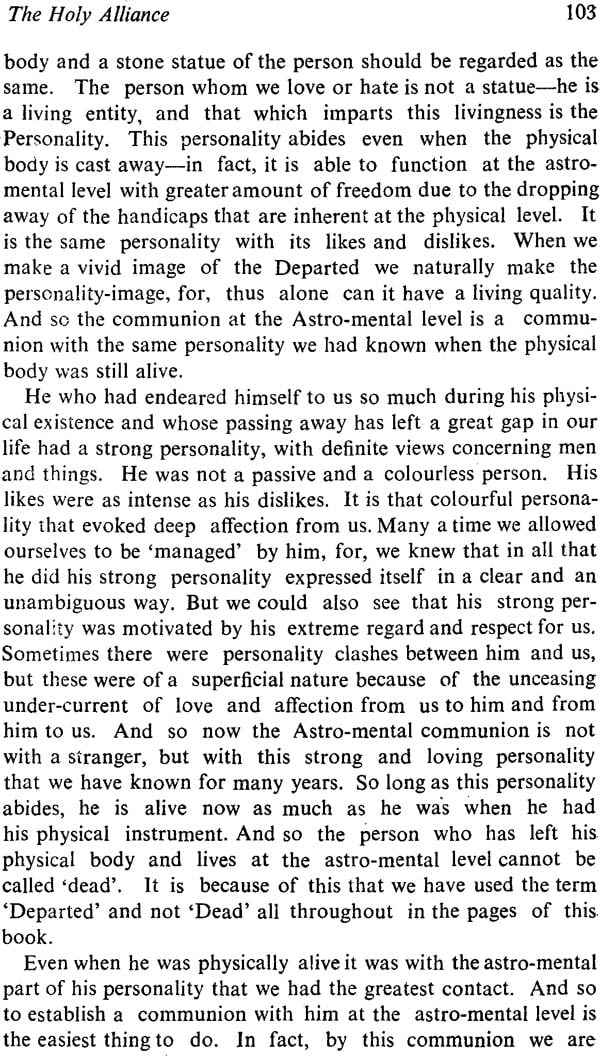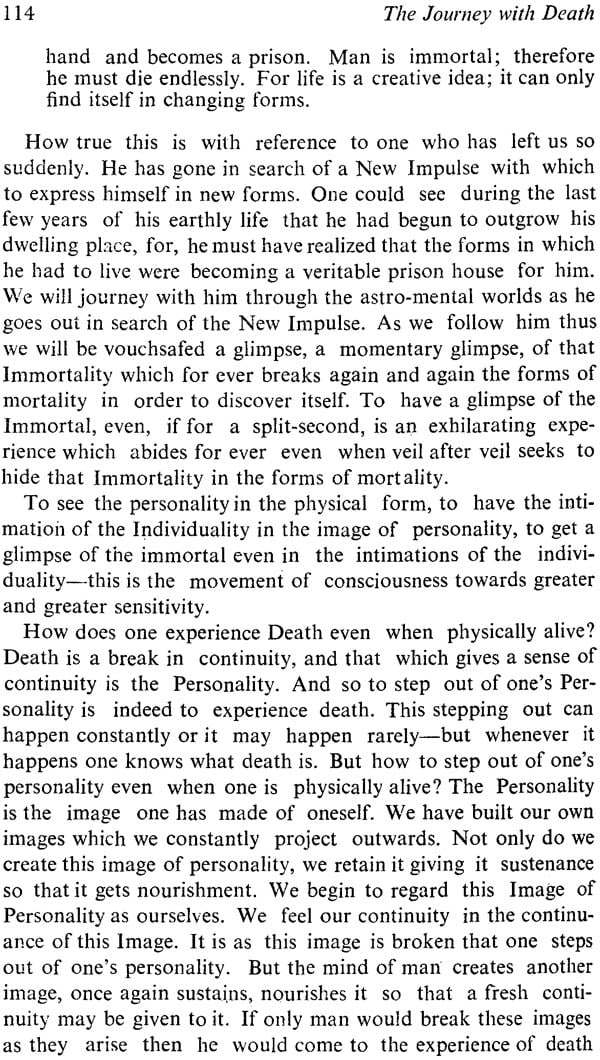
The Journey with Death
Book Specification
| Item Code: | IDD247 |
| Author: | Rohit Mehta |
| Publisher: | Motilal Banarsidass Publishers Pvt. Ltd. |
| Language: | English |
| Edition: | 2007 |
| ISBN: | 9788120802964 |
| Pages: | 125 |
| Cover: | Paperback |
| Other Details | 8.5" x 5.5" |
| Weight | 150 gm |
Book Description
About the Book
The Journey with Death deals with the problem of Death as well as the problem of Life. Avoiding the traditional approach to Death which consists of a description of the After-Death condition, the author has tried to find a solution for the problems of Survival and Reincarnation, of Communication with the dead and of the Interval between two lives. He has also dealt with the problem of Separation which Death poses to ordinary men and women. The author would prefer to call the so-called Dead as only the Departed with whom one can establish links of communication, through a wilful journey into the realms of Consciousness.
The book is refreshingly original in its content and presentation. As Miss Joy Mills, the International Vice-President of the Theosophical Society, says in her Foreword: "We most heartily commend this small book as rich in understanding, to all who seek to probe the mystery of Death, a mystery which is also the profound mystery of life itself."
About the Author
Rohit Mehta was born in 1908 and was educated at Bombay, Surat and Ahmedabad. Mehta was a founder of the Congress Socialist group which came into existence in 1934, and which later on become the Socialist Party of India. But while he accepted the economics of socialism, he was deeply dissatisfied with the philosophy of socialism. This led him to become an active worker in the Theosophical Society. He became an International Secretary of the society when Dr. G.S. Arundale was the President. He became the General Secretary of the Society for India, and Functioned as such for 16 years.
Mr. Mehta was author of a large number of books, viz., the call of the Upanishads, The Fullness of the Void, J. Krishnamurti and Sant Kabir, J. Krishnamurti and the Nameless Experience, The Dialogue with Death, Science of Meditation, From Mind to Super Mind, and The Secret of Self Transformation: A Synthesis of Tantra and Yoga all published by Motilal Banarsidass Publishers Private Limited.
THE mystery of death has always been one of the greatest challenges to the human mind. Few individuals can grow to adulthood without experiencing the separation and loss occasioned by the death of a loved one, and at some time or other every one confronts the thought of his own death. In some religious traditions, man is urged to meditate upon death, for such contemplation becomes a reminder that decisions cannot be postponed. Death, or its contemplation, does not reveal the futility of life, but its essential importance and value.
Out of the depths of his own experience in watching the shadow of death fall on one who has loved and cherished, Mr. Rohit Mehta has sought answers to the perennial questions that have haunted the human heart and mind for untold ages: What is death? Why does it come? Whither does it take one? Is death the end of existence? Can we communicate with the one who has passed through the portal of death? Will we meet again? Will we recognize each other? Mr. Mehta deals with these queries not merely from a philosophical basis of under- standing the events and conditions peculiar to the after-death states, but he takes the reader step by step on a journey of discovery that satisfies the inner longing for assurance and inspires the heart in its quest for peace.
In an ancient text, the neophyte is told: "Learn to die and thou shalt learn to live, for there shall none live that hath not learned to die." So this little work by Mr. Mehta, well known for his perceptive writings on a variety of subjects, may as well be called a journey into life, for he aids the reader in gaining a skill in living that matches the art of dying. Ultimately, as the author clearly shows, what we call death is a misnomer for him who has learned the nature of consciousness and its functioning. The habitual readiness to meet without fear whatever occurs to us .arises out of an attitude- that accepts life as a process, a process that includes both birth and death as natural, integral elements in the total process; of life itself. The problem, as our author so rightly points out, lies in the psychological realm, the world of thinking-feeling, in which we all exist whether with or without a physical base. For him who has learned the art of communion with another, physical separation, while still fraught with the pain of loss, does not lessen the essential rapport that unites those who truly love.
Particularly interesting, for those readers who accept the concept of reincarnation, is Mr. Mehta's discussion on the interval between lives. His reasoned exposition seems especially valid in the light of today's quickened pace of events. He places emphasis. on the reincarnating process as creative, rather than repetitive, and distinguishes clearly between the continuity of personality factors and the introduction of a new impulse from the realm of individuality, so giving meaning and purpose to the process. Perhaps the greatest message of this little work is that the living and the one who has cast aside his physical vesture may still move together, each helping the other even though on opposite sides of a doorway we call death, and that, finally, it is Love that holds the secret of recognition and that abolishes all doorways.
We most heartily commend this small book, so rich in under- standing, to all who seek to probe the mystery of death, a mystery which is also the profound mystery of life itself.
DEATH is a great enigma, perhaps the greatest which has baffled man from the earliest of times. It is because of this that thinkers and scholars all over the world, and, in all ages, have written about it. It is not at all strange that the Kathopanishad has attracted the attention of people in all countries, for, it discusses the problem of Death. Almost all religious philosophies have dealt with this subject from their respective angles. Much has been written about Death, about survival after Death and about communication with the dead in modern times. Among the large number of books written on Death by scholars of our times, there is nothing so illuminating as the exposition of the subject contained in modern theosophical literature.
When such a large and illuminating literature on Death is available, why do I dare to write on it? Have I anything more to add which is not to be found in the scholarly books that are there in large numbers, and, to which anyone, who is interested in the subject, can turn? I have no claim to scholarship. Then what is the excuse for my attempting to write on a subject which has been so widely discussed all over the world and that too by men and women of great eminence?
I have read, and read carefully most of the books that have been written on the subject of Death, both in the East as well as the West. But I had never seen Death at such close quarters as I did recently when a very dear friend passed away. I almost heard the footsteps of Death as it arrived. It was a shattering experience. I did nothing to soften the impact of this experience; I sought no explanations in terms of what I had read; I did not seek avenues of escape so as to erase the memory of that unfor- gettable event. I did not want to take shelter under the passage of time where it is said all wounds are healed. I wanted the impact of Death to strike me with its hardest blows. I allowed this impact to do what it liked, even to uproot me if it so desired.
My excuse in writing this book is to share with others what this impact did to me. It led me to new experiments and to revealing experiences with regard to Death and After. In the pages of this book I have only described that experiment to which the shattering impact led me. And as I moved along the lines indicated by that experiment I came to some startling experiences. It is these that I have narrated here in all humility. I speak with no authority on this vast and baffling subject. But I do feel that death is such a great mystery that no book, no authority however great, can unravel it completely. The secret of Death has to be discovered by each man for himself. The books and authorities may help, but in the ultimat analysis each man must move to his own discovery. In thes pages I have tried to describe my journey towards such a Discovery. I share my experiments and experiences, for what- ever they are worth, with others who may be interested in the subject of Death, and who may be on their own way to the Discovery of the Great Secret of Secrets.
I am very grateful to Miss Joy Mills, the International Vice- President of the Theosophical Society; for writing a foreword for this book. This has added considerably to the value of the book.
| Foreword - Joy Mills | v-vi | |
| Preface | vii-viii | |
| I | A Silent Witness | 1-8 |
| II | Beyond the Gateway | 9-15 |
| III | The New Horizons | 16-24 |
| IV | A Contact without a Communion | 25-37 |
| V | A Refreshing Sleep | 38-50 |
| VI | The Opening of the Door | 51-72 |
| VII | A New Fraternity | 73-88 |
| VIII | The Secret of Recognition | 89-101 |
| IX | The Holy Alliance | 102-117 |
